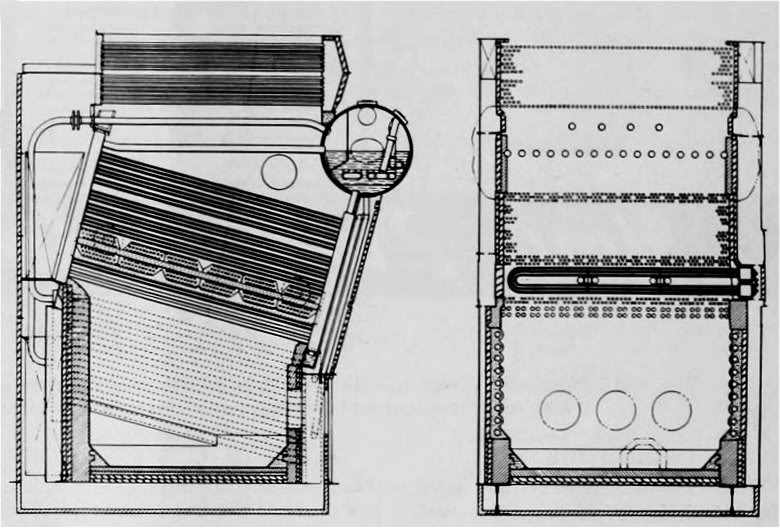Auke Visser's International Esso Tankers site | home
Efficient Boiler Equipment on New Tankers
SS Esso Baytown.
Two tankers, the Wallace E. Pratt and the Esso Baytown, were recently completed by the Sun Shipbuilding and Dry Dock Company, and after thorough sea trials delivered to the Standard Oil Company of New Jersey.
Both of these tankers passed their tests very satisfactorily and are now in commission, giving very economical service in overseas oil transport for their owners.
Both ships are driven by Westinghouse cross compound, double reduction gear, impulse-reaction turbines developing normally 3500 shaft horsepower at 85 revolutions a minute on the propeller shaft.
Steam is supplied by two Babcock & Wilcox oil-burning boilers equipped with steam superheaters, air preheaters, and watercooled furnaces.
The boilers are of sectionalheader, single-pass type, designed to operate with a steam pressure of 425 pounds at the superheater outlet.
Sinuous headers are used to obtain uniform tube staggering, so as to have all the generating tube surface swept by the combustion gases to obtain high efficiency. At normal operation the steam capacity of the two units is 33,500 pounds, and at maximum capacity, 62,700 pounds, with 725 F, steam temperature.
The superheaters are of the interdeck type, arranged with the tubes running transverse to the boiler tubes and extending the entire width of the boiler.
The superheater headers, into which the tubes are expanded, are located between the outer and inner boiler casings and are readily accessible.
There are four rows of boiler tubes between the superheater and the furnace, thus protecting the superheater tubes from direct flame impingement from the oil burners.
Steam desuperheaters of the internal-drum submerged type furnish the low temperature steam required for auxiliary purposes.
By the use of air heaters, the gases from the boilers preheat the air for combustion to approximately 350 degrees.
 Fore-and-aft and thwartship sectional elevations of Babcock and Wilcox marine water tube
The temperature of the gases boiler of the sectional-header, single pass type, leaving the air heater and entering the stack is 280 degrees, indicating the heat extracting characteristics of this design of boiler unit. The use of an air heater has the following definite advantages:
1. Improved overall heat balance of the ship;
2. Improved combustion due to the use of high combustion air temperature;
3. Lower maintenance with the use of non-pressure parts for heat recovery.
The water-cooled furnace sidewalls consist of a vertical row of inclined tubes expanded into headers at the front and rear of each wall. These tubes are of B&W Stud-Tube construction in which studs welded to the face of the tubes on the furnace side hold securely a covering of chrome plastic refractory around and between the tubes. The chrome refractory covering on the tubes will not only resist the high furnace temperatures incident to oil firing, but also the slagging action that would be encountered with ordinary refractory, resulting in low furnace maintenance.
The feedwater temperature will be 300 degrees, and the flow will be regulated to maintain a constant level in the drum by a Bailey Thermal feedwater regulator.
With the improved spacing and arrangement of boiler tubes and air heater tubes, it is not necessary to resort to any baffling to deflect the gases over the different parts of the heating surfaces. The omission of baffles in the air heater gives a straight gasflow, and eliminates ledges or pockets where soot would collect, and which might be a fire hazard as well as a corrosion hazard.
This design of boiler, with all the generating, superheater, and waterwall tubes accessible for inspection, cleaning, and repair from the outside of the boiler, is particularly desirable for tanker service, in which the ships are at sea the greater part of the time, and remain in port usually only a matter of hours.
The boiler is encased in a double casing so arranged that all the air for combustion passes around the boiler casings and headers, reducing the heat loss from radiation to a minimum, and maintaining the fireroom comfortably cool.
Sufficient soot blowers are provided to maintain the heating surfaces clean at all times.
|